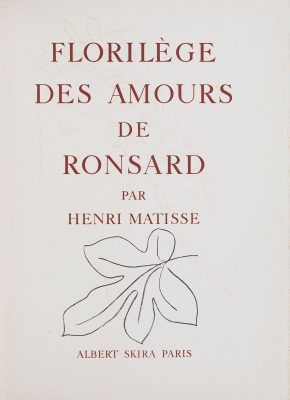
Frontispiece
View all works in the seriesH. Matisse. Florilège des Amours par Ronsard. Paris: Bibliotheque des Arts, 1948. Limited edition of 320 copies.
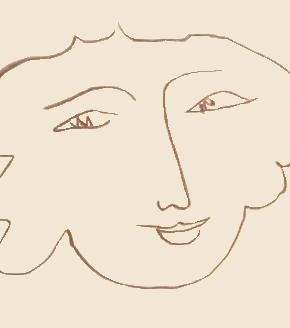
Smiling face
View all works in the seriesH. Matisse. [Smiling face]. Lithograph, 1948, from Florilège des Amours par Ronsard, total edition of 320 copies. Dimensions: sheet 29.5 x 26.5 cm. Reference: Duthuit Ouvrages illustrés no. 25 p 197.

Nude bathing
View all works in the seriesH. Matisse. [Nude bathing]. Lithograph, 1948, from Florilège des Amours par Ronsard, total edition of 320 copies. Dimensions: sheet 38 x 28 cm. Reference: Duthuit Ouvrages illustrés no. 25 p 198.
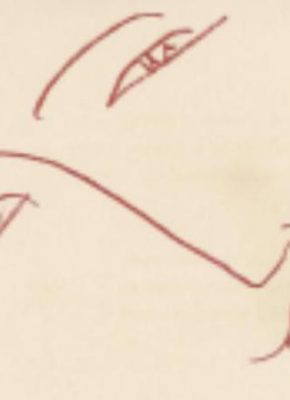
Face of a Woman
View all works in the seriesH. Matisse. [Face of a Woman]. Lithograph, 1948, from Florilège des Amours par Ronsard, total edition of 320 copies. Dimensions: Sheet 28 x 18 cm. Reference: Duthuit Ouvrages illustrés no. 25 p 198.
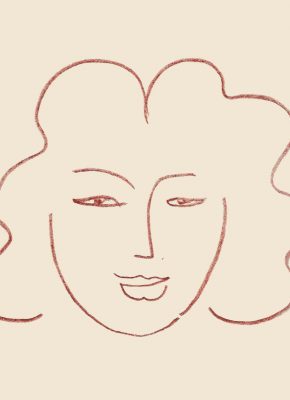
Face of a young woman
View all works in the seriesH. Matisse. [Face of a young woman]. Lithograph, 1948, from Florilège des Amours par Ronsard, total edition of 320 copies. Dimensions: sheet 24 x 28 cm. Reference: Duthuit Ouvrages illustrés no. 25 p 198
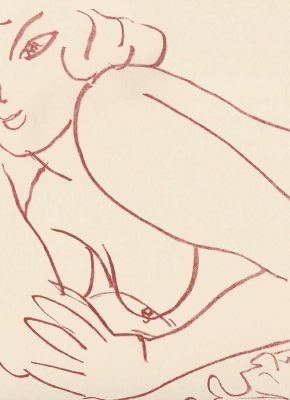
Nude leaning forward
View all works in the seriesH. Matisse. [Nude leaning forward]. Lithograph, 1948, from Florilège des Amours par Ronsard, total edition of 320 copies. Dimensions: sheet 25 x 28 cm. Reference: Duthuit Ouvrages illustrés no. 25 p 199.
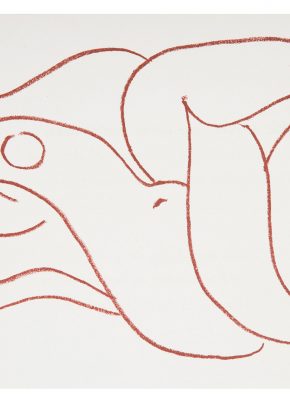
Embracing Lovers 1
View all works in the seriesH. Matisse. [Embracing Lovers 1]. Lithograph, 1948, from Florilège des Amours par Ronsard, total edition of 320 copies. Dimensions: sheet 25 x 28 cm. Reference: Duthuit Ouvrages illustrés no. 25 p 199.
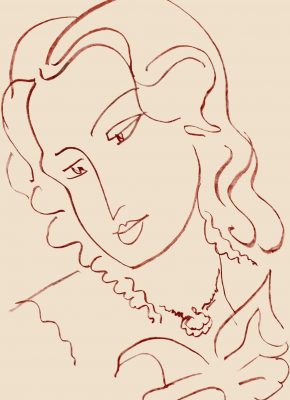
Portrait of a Woman
View all works in the seriesH. Matisse. [Portrait of a Woman
]. Lithograph, 1948, from Florilège des Amours par Ronsard, total edition of 320 copies. Dimensions: sheet 38.4 x 28 cm. Reference: Duthuit Ouvrages illustrés no. 25 p 199.

Profile of a woman
View all works in the seriesH. Matisse. [Profile of a Woman]. Lithograph, 1948, from Florilège des Amours par Ronsard, total edition of 320 copies.. Dimensions: sheet 38.4 x 28 cm. Reference: Duthuit Ouvrages illustrés no. 25 p. 199
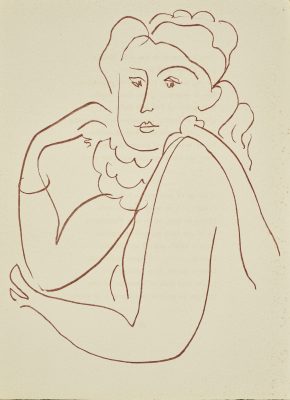
Bust of a young woman
View all works in the seriesH. Matisse. [Bust of a young Woman]. Lithograph, 1948, from Florilège des Amours par Ronsard, total edition of 320 copies. . Dimensions: sheet 38.4 x 28 cm. Reference: Duthuit Ouvrages illustrés no. 25 p. 201

Torso [I]
View all works in the seriesH. Matisse. Torso [I]. Lithograph, 1948, from Florilège des Amours par Ronsard, total edition of 320 copies. Dimensions: sheet 38 x 28 cm. Reference: Duthuit Ouvrages illustres no. 25 p 202.
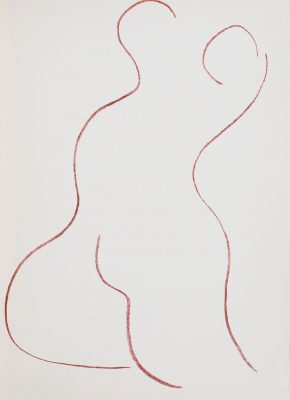
Torso [II]
View all works in the seriesH. Matisse. Torso [II]. Lithograph, 1948, from Florilège des Amours par Ronsard, total edition of 320 copies. Dimensions: sheet 38 x 28 cm. Reference: Duthuit Ouvrages illustres no. 25 p 202.
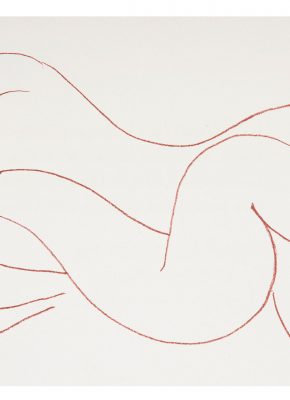
Embracing Lovers 2
View all works in the seriesH. Matisse. [Embracing Lovers 2]. Lithograph, 1948, from Florilège des Amours par Ronsard, total edition of 320 copies. Dimensions: sheet 25 x 28 cm. Reference: Duthuit Ouvrages illustrés no. 25 p 202.

Birdie
View all works in the seriesH. Matisse [Birdie]. Original Lithograph, 1948, from Florilège des Amours par Ronsard, total edition of 320 copies. Dimensions: sheet 28 x 19.5 cm. Reference: Duthuit Ouvrages illustres no. 25 p 202.

Portrait of a young Woman
View all works in the seriesH. Matisse [Portrait of a young woman]. Lithograph, 1948, from Florilège des Amours par Ronsard, total edition of 320 copies. Dimensions: sheet 38 x 28 cm. Reference: Duthuit Ouvrages illustres no. 25 p 202. The sitter for this portrait is very likely Lydia Delectorskaya, the devoted companion and carer of the Master’s last years.

Mermaid
View all works in the seriesH. Matisse. [Mermaid]. Lithograph, 1948, from Florilège des Amours par Ronsard, total edition of 320 copies. Dimensions: sheet 18 x 28 cm. Reference: Duthuit Ouvrages illustrés no. 25 p 202.
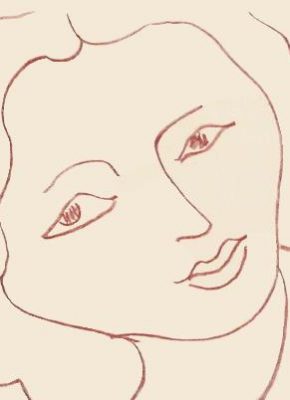
Face of a Woman
View all works in the seriesH. Matisse. [Face of a Woman]. Lithograph, 1948, from Florilège des Amours par Ronsard, total edition of 320 copies. Dimensions: sheet 25 x 28 cm. Reference: Duthuit Ouvrages illustrés no. 25 p 202.
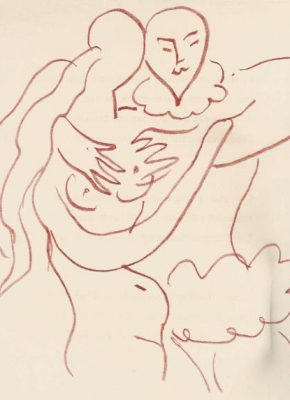
Nymph and Satyr
View all works in the seriesH. Matisse. [Nymph and Satyr]. Lithograph, 1948, from Florilège des Amours par Ronsard, total edition of 320 copies. Dimensions: sheet 28 x 26 cm. Reference: Duthuit Ouvrages illustrés no. 25 p 202.
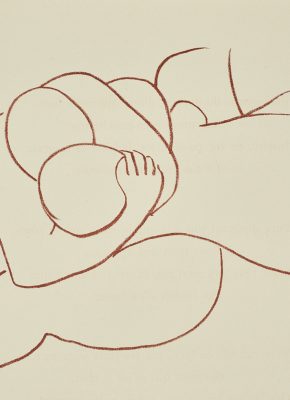
Embracing Couple
View all works in the seriesH. Matisse. [Embracing Couple]. Lithograph, 1948, from Florilège des Amours par Ronsard, total edition of 320 copies. Dimensions: sheet 25 x 28 cm. Reference: Duthuit Ouvrages illustrés no. 25 p. 203
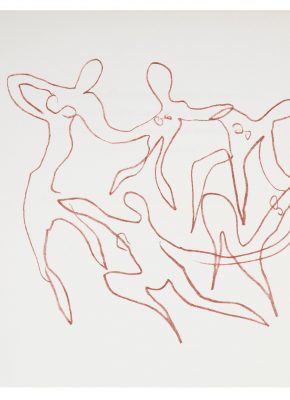
La Danse
View all works in the seriesH. Matisse. [La Danse]. Lithograph, 1948, from Florilège des Amours par Ronsard, total edition of 320 copies. Dimensions: sheet 25 x 28 cm. Reference: Duthuit Ouvrages illustrésno. 25 p 203.
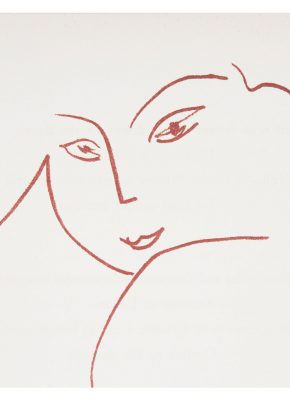
Face of a Young Woman
View all works in the seriesH. Matisse. [Face of a young woman]. Lithograph, 1948, from Florilège des Amours par Ronsard, total edition of 320 copies. Dimensions: sheet 18 x 28 cm. Reference: Duthuit Ouvrages illustrés no. 25 p 203.
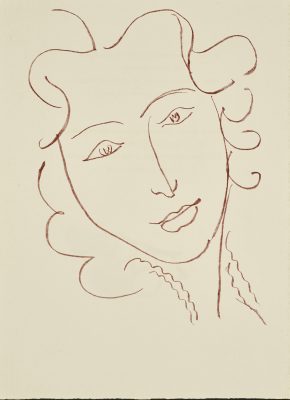
Portrait of a young Lady
View all works in the seriesH. Matisse. [Portrait of a young Lady]. Lithograph, 1948, from Florilège des Amours par Ronsard, total edition of 320 copies. Dimensions: sheet 38.4 x 28 cm. Reference: Duthuit Ouvrages illustrés no. 25 p. 204
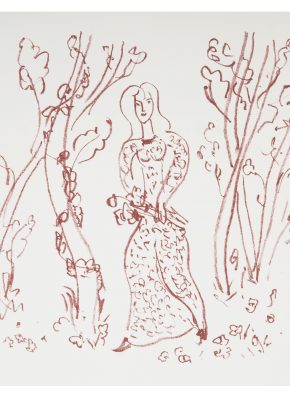
The Flower Picker
View all works in the seriesH. Matisse. [The Flower Picker]. Lithograph, 1948, from Florilège des Amours par Ronsard, total edition of 320 copies. Dimensions: sheet 28 x 25 cm. Reference: Duthuit Ouvrages illustrés no. 25 p. 204
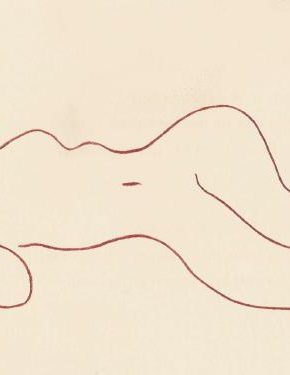
Reclining Nude Torso
View all works in the seriesH. Matisse. [Reclining Nude Torso]. Lithograph, 1948, from Florilège des Amours par Ronsard, total edition of 320 copies. Dimensions: sheet 18 x 28 cm. Reference: Duthuit Ouvrages illustrés no. 25 p. 205
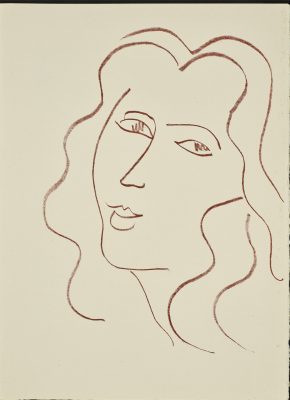
Head of a Young Woman
View all works in the seriesH. Matisse. [Head of a young woman]. Lithograph, 1948, Florilège des Amours par Ronsard, total edition of 320 copies. Dimensions: sheet 38.4 x 28 cm. Reference: Duthuit Ouvrages illustrés no. 25 p 205.
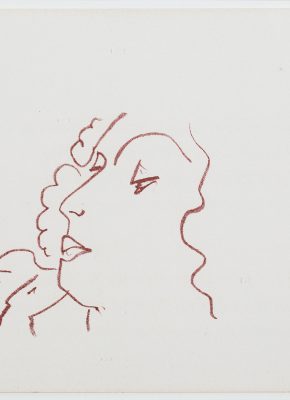
Head of a Woman Looking Down
View all works in the seriesH. Matisse. [Head of a Woman Looking Down]. Lithograph, 1948, from Florilège des Amours par Ronsard, total edition of 320 copies. Dimensions: sheet 18 x 28 cm. Reference: Duthuit Ouvrages illustréss no. 25 p 205.
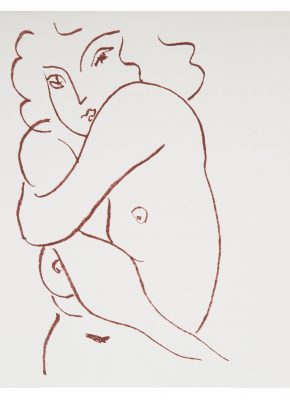
Modest Nude
View all works in the seriesH. Matisse. [Modest Nude]. Lithograph, 1948, from Florilège des Amours par Ronsard, total edition of 320 copies. Dimensions: sheet 25 x 28 cm. Reference: Duthuit Ouvrages illustréss no. 25 p 205.
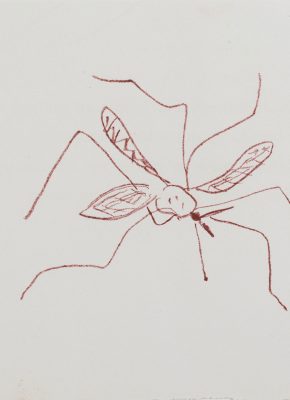
Mosquito
View all works in the seriesH. Matisse. [Mosquito]. Lithograph, 1948, from Florilège des Amours par Ronsard, total edition of 320 copies. Dimensions: Sheet 18 x 28 cm. Ref: Duthuit Ouvrages illustrés no. 25 p 205. For details of this particular mosquito’s life see Hilary Spurling biography of Matisse: “By the middle of August [1942] Matisse had spent nearly six months in bed. Lydia caught an outsize mosquito with a proboscis like an elephant’s trunk, just as Ronsard’s poem, and imprisoned it under an inverted glass by the painter’s bed for him to draw[…]. The mosquito drawing became a tailpiece for the sonnet in its honour” (Spurling, H. Matisse the Master. London: Hamish Hamilton, 2005 p 410.
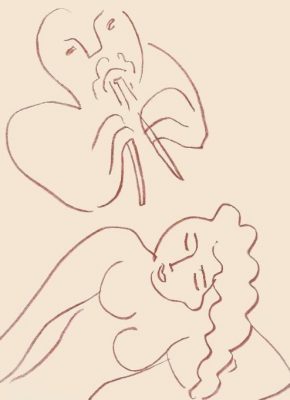
Piper and Nude
View all works in the seriesH. Matisse. [Piper and Nude]. Lithograph, 1948, from Florilège des Amours par Ronsard, total edition of 320 copies. Dimensions: sheet 38 x 28 cm. Reference: Duthuit Ouvrages illustréss no. 25 p 206.
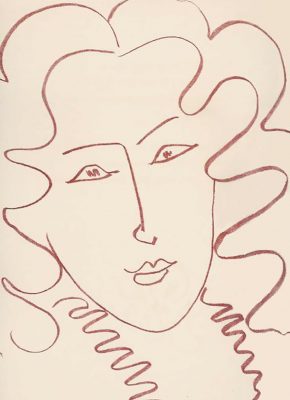
Portrait of a Woman
View all works in the seriesH. Matisse. [Portrait of a Woman]. Lithograph, 1948, from Florilège des Amours par Ronsard, total edition of 320 copies. Dimensions: sheet 24.5 x 28 cm. Reference: Duthuit Ouvrages illustres no. 25 p 206.

Torso III
View all works in the seriesH. Matisse. [Torso III]. Lithograph, 1948, from Florilège des Amours par Ronsard, total edition of 320 copies. Dimensions: sheet 38.4 x 28 cm. Reference: Duthuit Ouvrages illustrés no. 25 p. 206
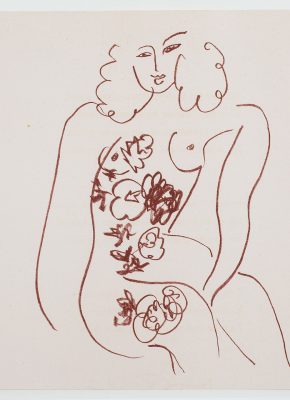
Nude with Flowers
View all works in the seriesH. Matisse. [Nude with Flowers]. Lithograph, 1948, from Florilège des Amours par Ronsard, total edition of 320 copies. Dimensions: sheet 24.5 x 28 cm. Reference: Duthuit Ouvrages illustres no. 25 p 206.
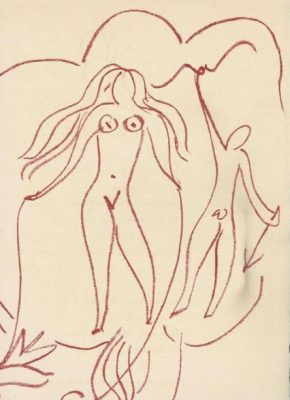
Venus and Cupid
View all works in the seriesH. Matisse. [Venus and Cupid]. Lithograph, 1948, from Florilège des Amours par Ronsard, total edition of 320 copies. Dimensions: sheet 38.5 x 27 cm. Reference: Duthuit Ouvrages illustres no. 25 p 207.
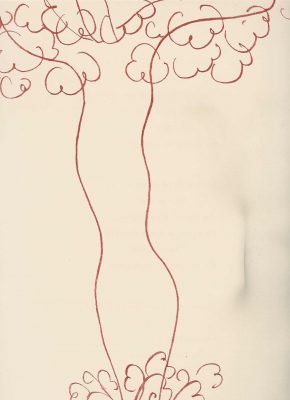
Daphne
View all works in the seriesH. Matisse. [Daphne]. Lithograph, 1948, from Florilège des Amours par Ronsard, total edition of 320 copies. Dimensions: sheet 28 x 38 cm. Reference: Duthuit Ouvrages illustres no. 25 p 207.
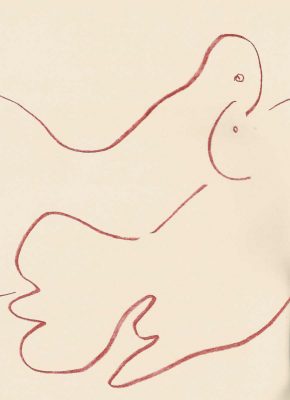
Doves
View all works in the seriesH. Matisse. [Doves]. Lithograph, 1948, from Florilège des Amours par Ronsard, total edition of 320 copies. Dimensions: sheet 27.5 x 23.5 cm. Reference: Duthuit Ouvrages illustres no. 25 p 207.
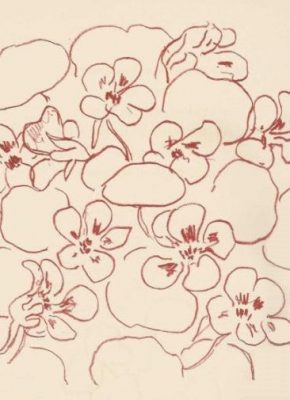
Group of Flowers
View all works in the seriesH. Matisse. [Group of Flowers]. Lithograph, 1948, from Florilège des Amours par Ronsard, total edition of 320 copies. Dimensions: sheet 25 x 28 cm. Reference: Duthuit Ouvrages illustres no. 25 p 207.
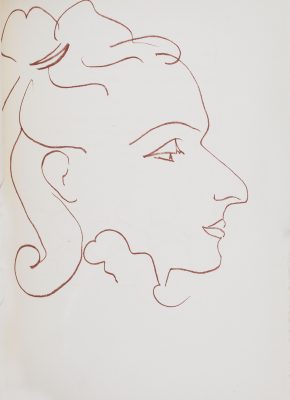
Profile of a Woman
View all works in the seriesH. Matisse. [Profile of a Woman.] Lithograph, 1948, from Florilège des Amours par Ronsard, total edition of 320 copies. Dimensions: sheet 38 x 28 cm. Reference: Duthuit Ouvrages illustres no. 25p 208.
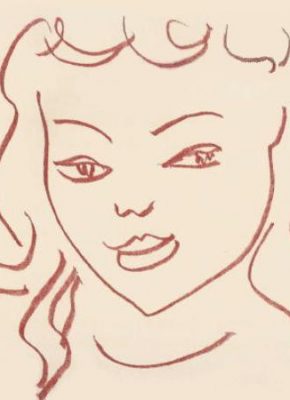
Face of a young woman
View all works in the seriesH. Matisse. [Face of a young woman]. Lithograph, 1948, from Florilège des Amours par Ronsard, total edition of 320 copies. Dimensions: sheet 25 x 28 cm. Reference: Duthuit Ouvrages illustres no. 25p 208.
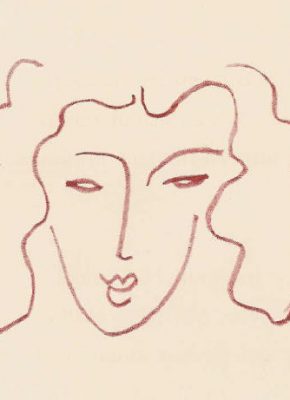
Small face
View all works in the seriesH. Matisse. [Small face]. Lithograph, 1948, from Florilège des Amours par Ronsard, total edition of 320 copies. Dimensions: sheet 24 x 18 cm. Reference: Duthuit Ouvrages illustres no. 25p 209.
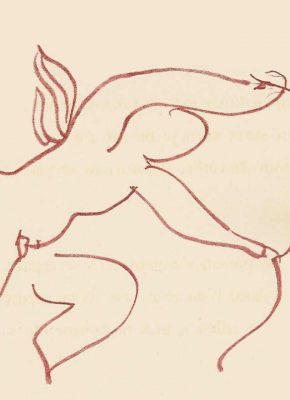
Cupid
View all works in the seriesH. Matisse. [Cupid]. Lithograph, 1948, from Florilège des Amours par Ronsard, total edition of 320 copies. Dimensions: sheet 28 x 18 cm. Reference: Duthuit Ouvrages illustres no. 25p 209.
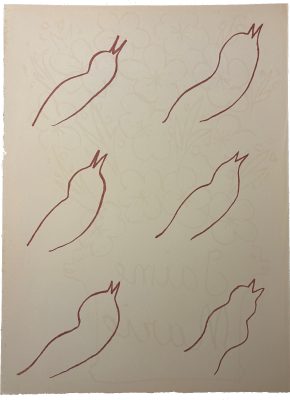
Singing birds
View all works in the seriesH. Matisse. [Singing birds]. Lithograph, 1948, from Florilège des Amours par Ronsard, total edition of 320 copies. Dimensions: sheet 28 x 38.5 cm. Reference: Duthuit Ouvrages illustres no. 25p 210.
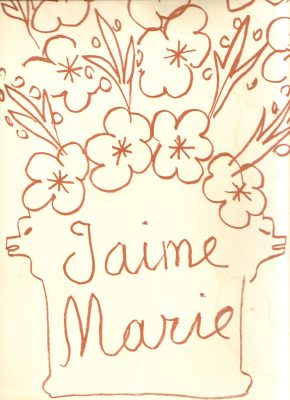
Jaime Marie
View all works in the seriesH. Matisse. [Jaime Marie]. Lithograph, 1948, from Florilège des Amours par Ronsard, total edition of 320 copies. Dimensions: sheet 28 x 38.5 cm. Reference: Duthuit Ouvrages illustres no. 25p 211.
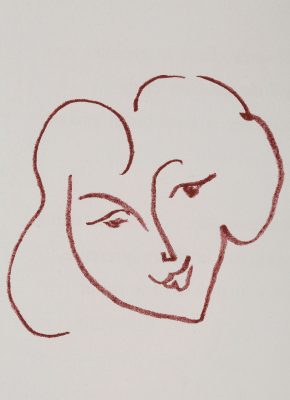
Small Head
View all works in the seriesH. Matisse. [Small head.] Lithograph, 1948, from Florilège des Amours par Ronsard, total edition of 320 copies. Dimensions: sheet 18 x 23 cm. Reference: Duthuit Ouvrages illustres no. 25p 212.
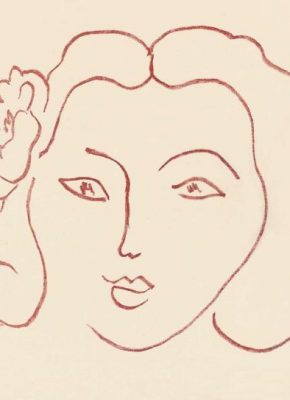
A young woman with flower
View all works in the seriesH. Matisse. [A young woman with flower]. Lithograph, 1948, from Florilège des Amours par Ronsard, total edition of 320 copies. Dimensions: sheet 28 x 24 cm. Reference: Duthuit Ouvrages illustres no. 25p 212.

Kiss
View all works in the seriesH. Matisse. [Kiss]. Lithograph, 1948, from Florilège des Amours par Ronsard, total edition of 320 copies. Dimensions: sheet 19 x 28 cm. Reference: Duthuit Ouvrages illustres no. 25p 212.
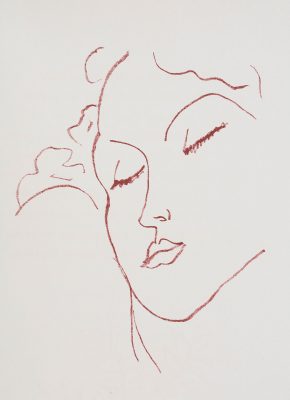
Sleeping Beauty
View all works in the seriesH. Matisse. [Sleeping Beauty.] Lithograph, 1948, from Florilège des Amours par Ronsard, total edition of 320 copies. Dimensions: sheet 25 x 28 cm. Reference: Duthuit Ouvrages illustres no. 25 p 212.
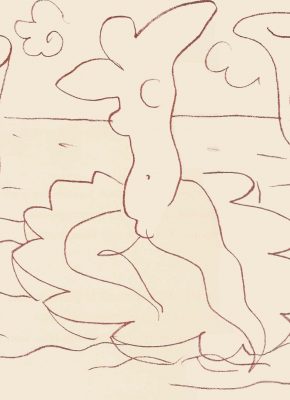
Birth of Venus
View all works in the seriesH. Matisse [Birth of Venus]. Lithograph, 1948, from Florilège des Amours par Ronsard, total edition of 320 copies. Dimensions: sheet 25 x 28 cm. Reference: Duthuit Ouvrages illustres no. 25 p 213.
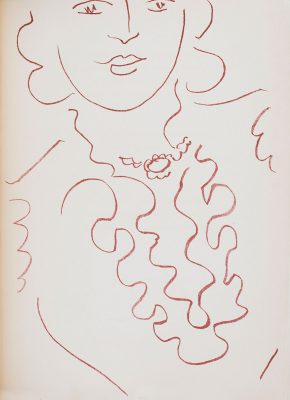
Portrait of a Woman in a Ruffled Shirt
View all works in the seriesH. Matisse. [Portrait of a Woman in a Ruffled Shirt]. Lithograph, 1948, from Florilège des Amours par Ronsard, total edition of 320 copies. Dimensions: sheet 38 x 28 cm. Reference: Duthuit Ouvrages illustrés no. 25 p 213.
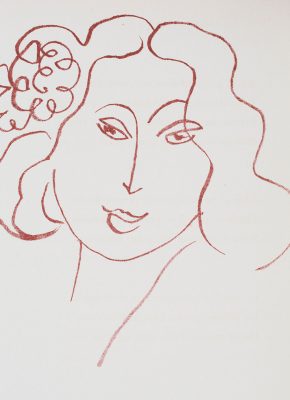
Young Lady with Flower in her Hair
View all works in the seriesH. Matisse. [Young Lady with Flower in her Hair]. Lithograph, 1948, from Florilège des Amours par Ronsard, total edition of 320 copies. Dimensions: sheet 24.5 x 28 cm. Ref:Duthuit Ouvrages illustrés no. 25 p 213.
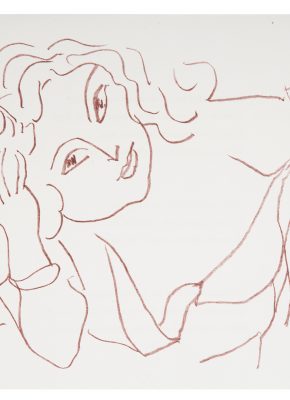
Bust of a Woman
View all works in the seriesH. Matisse. [Bust of a Woman]. Lithograph, 1948, from Florilège des Amours par Ronsard, total edition of 320 copies. Dimensions: sheet 25 x 28 cm. Reference: Duthuit Ouvrages illustrés no. 25 p 213.

Head with Flower
View all works in the seriesH. Matisse. [Head with flower]. Lithograph, 1948, from Florilège des Amours par Ronsard, total edition of 320 copies. Dimensions: sheet 18 x 28 cm. Reference: Duthuit Ouvrages illustrés no. 25 p 213.
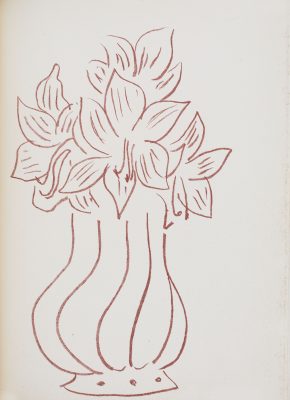
Vase of Lilies [1]
View all works in the seriesH. Matisse. Vase of Lilies [1] . Lithograph, 1948, from Florilège des Amours par Ronsard, total edition of 320 copies. Dimensions: sheet 38.4 x 28 cm. Ref. Duthuit Ouvrages illustrés no. 25 p 213.
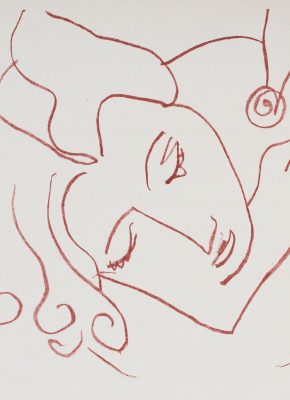
Resting Woman
View all works in the seriesH. Matisse. [Resting Woman]. Lithograph, 1948, from Florilège des Amours par Ronsard, total edition of 320 copies. Dimensions: sheet 23 x 28 cm. Ref: Duthuit Ouvrages illustrés, no.25, p. 214
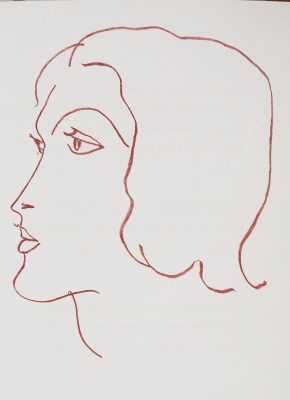
Profile of a Young Woman with Short Hair
View all works in the seriesH. Matisse. [Profile of a young woman with short hair.] Lithograph, 1948, from Florilège des Amours par Ronsard, total edition of 320 copies. Dimensions: sheet 25 x 28 cm. Reference: Duthuit Ouvrages illustres no. 25 p 214.
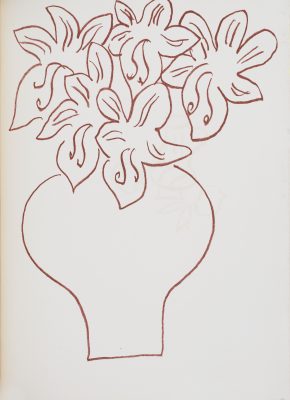
Vase of Lilies [2]
View all works in the seriesH. Matisse. Vase of Lilies [2]. Lithograph, 1948, from Florilège des Amours par Ronsard, total edition of 320 copies. Dimensions: sheet 38.4 x 28 cm. Ref.: Duthuit Ouvrages illustrés no. 25 p 214.
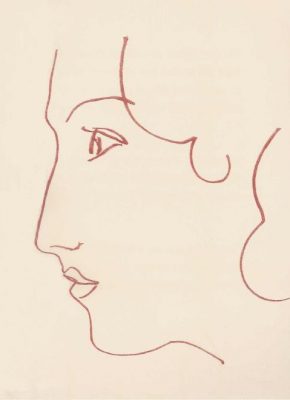
Portrait of a Woman in Profile
View all works in the seriesH. Matisse. [Portrait of a Woman in Profile ]. Lithograph, 1948, from Florilège des Amours par Ronsard, total edition of 320 copies. Dimensions: sheet 38 x 28 cm. Ref: Duthuit Ouvrages illustrés no. 25 p 214.
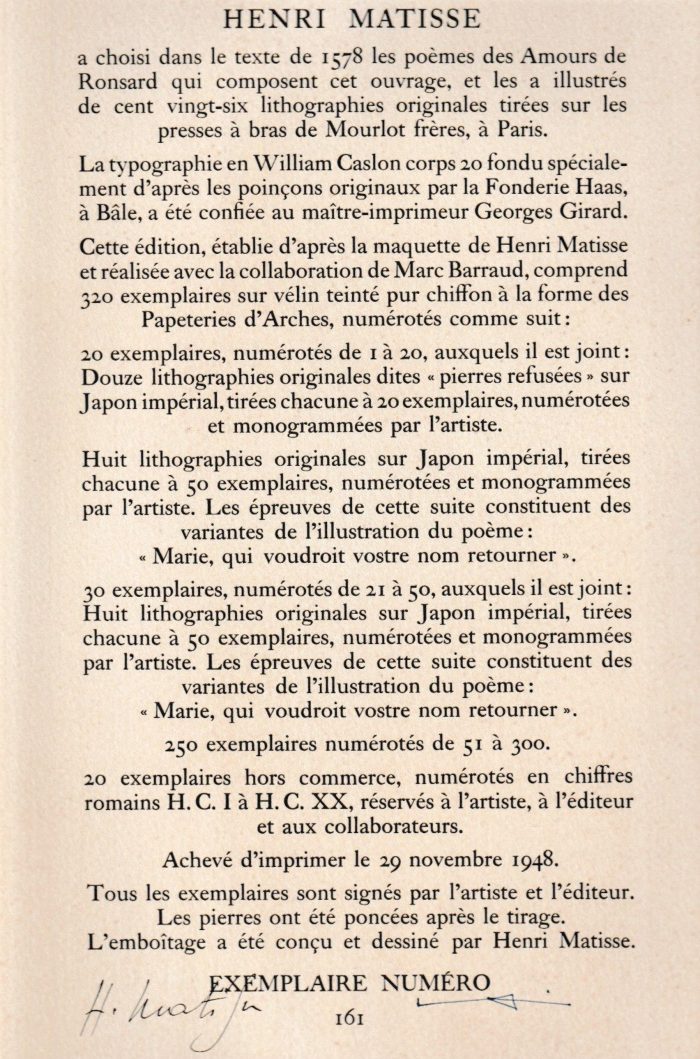
The justification page of the book, signed by Matisse lower left
Matisse started working on the Florilège project, in collaboration with the publisher Albert Skira in 1941, but it took 7 years for the work to be completed. The delay was due partly to the war and difficulties with the font types, but also to the enormous amount of time and attention that Matisse himself spent on the project, from the actual creation of the images down to all the minutiae of the printing of the lithographs.
Correspondence shows that for long periods, from 1941 onwards, Matisse was completely absorbed on the work on Ronsard. The book was finally printed and published in 1948. Mourlot printed the lithographs. The total edition was of 320 copies; each copy was numbered, and signed by Matisse on the justification page. Nowadays Florilège des Amours is universally considered as the most typical and important livre d’artiste by Matisse: of particular note is the tone of sepia used for the lithographs, unique to this series.
The sensuality of the female bodies and portraits is another unique feature of this series and this particular period in the artist’s life: this is in immediately apparent contrast with the earlier graphic work, much more angular and unwilling to please the eye, and the subsequent, more rarefied and austere representations in the Chapel at Aix and the mysterious aquatints of the final years of Matisse’s life.
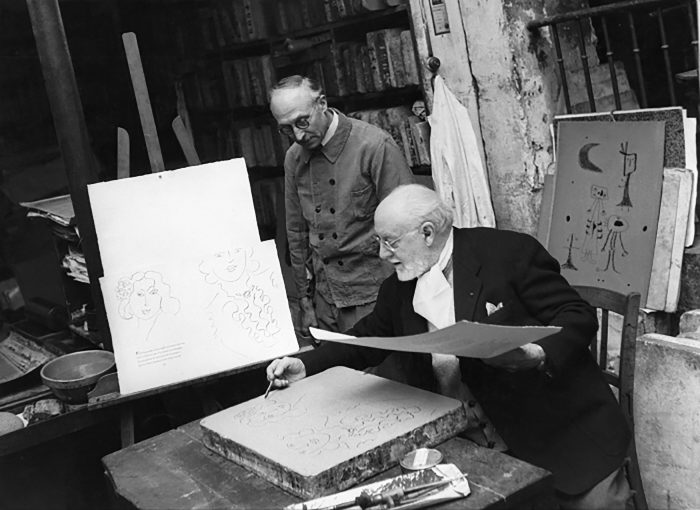
1948: Matisse at Mourlot Freres in Paris checking the freshly printed proofs of Florilège against the stones.
The full title of the work is Florilège des Amours par Ronsard, where florilège (a choice of flowers) is a very elegant way to say” anthology” and amours is an abbreviation of “love sonnets”. Ronsard, of course, was Pierre de Ronsard ((1524-1585), one of the greatest French poets, quite famous in his lifetime and immediately afterwards, somehow forgotten by the general public afterwards. So the book is actually a curated choice of Ronsard’s best sonnets, illustrated by Matisse. However, the inspiration for most of the images is only loosely connected with the Ronsard poems; Matisse writes, at an early stage, of his desire for doing, above all, “..some Matisse..” for the project, no doubt meaning that he intended to draw inspiration on his personal imagery rather than the poems. In the end, the series of lithograph came to represent a complete summary of Matisse’s journey.
All lithographs in the normal edition of this series (250 copies) are unsigned, the total edition was 320 copies. All our lithographs from this series come from the following copy: Florilège des Amours par Ronsard. Paris: Albert Skira, 1948. Copy number 161 of 320. As called for, the justification page is signed by Matisse and the publisher Skira.
The standard reference work for this series, as well as for all Matisse graphics published in books, is: Duthuit, Claude. Henri Matisse: catalogue raisonne’ des ouvrages illustres. Paris 1988. Florilege is catalogued there under number 25.
The only work in English with a description of Matisse’s Ronsard is: Bidwell, John. Graphic Passion: Matisse and the Book Arts. Univ. Park: Pennsylvania Univ. Press, 2015. Ronsard is analysed at no. 38, pp 192-197.
